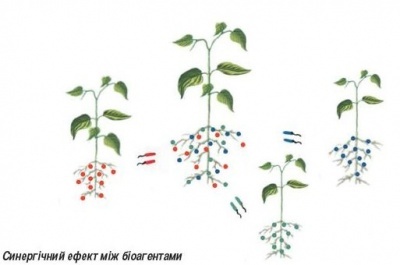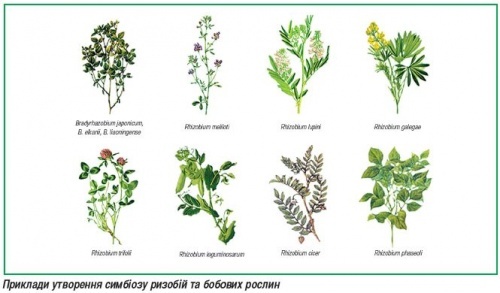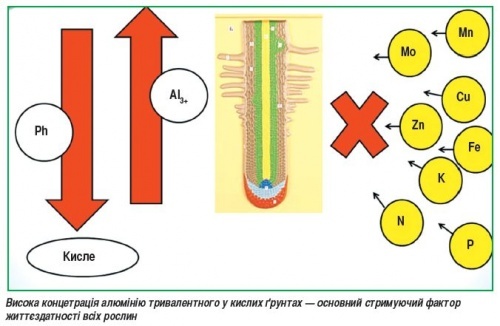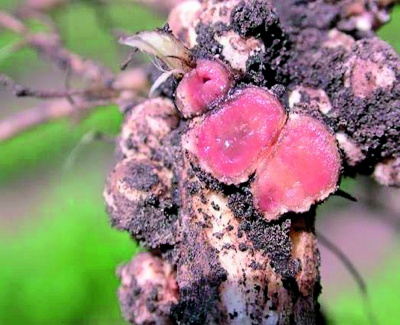Factors for the existence of symbiosis b. japonicum - soy
What is the symbiosis of nodule bacteria and soybeans? A concept or phenomenon that scientists use to scare producers, which causes a serious barrier in communication between them: scientists are in pain because their knowledge is not perceived, farmers need specific practical answers to their questions. So what is symbiosis and what factors actually influence its occurrence?
Symbiosis is a biological system created by leguminous plants and nodule bacteria, the result of the interaction of which is the formation of new morphological structures - root nodules. The latter convert atmospheric nitrogen into a form available to plants - this is a complex, multi-stage process that causes profound physiological and metabolic changes in both partners.
One of the most important factors in the occurrence of symbiosis is the presence of nodule bacteria in the rhizosphere of plants. What are these microorganisms? Nodule nitrogen-fixing bacteria, or rhizobia, are soil microorganisms capable of carrying out the process of biological nitrogen fixation. The first classification of rhizobia was developed back in the 30s of the last century, it was based on the ability of microorganisms to enter into a symbiotic relationship with the host plant. Then only six species were identified - Rhizobium meliloti, R. trifolii, R. phaseoli, R. lupini, R. leguminosarum, R. japonicum. 50 years later, the taxonomy of these microorganisms was revised and, according to a number of genetic and morphophysiological properties, a new genus of rhizobia, Bradyrhizobium, was identified, a characteristic feature of which was a low growth rate. It is the representatives of this species that are microsymbionts exclusively of soybean plants. 
The latter, in turn, was divided into three types of bacteria: Bradyrhizobium japonicum, B. elkanii, B. liaoningense.
The active use of inoculants during soybean cultivation in different countries of the world, including Ukraine, led to the formation of rhizobia populations in soils, which, as a result of free existence and the influence of various abiotic factors, changed their genotype and acquired new properties.
Thus, according to the data of molecular genetic studies, several groups of strains are distinguished among them, differing in their properties, including the growth rate. Today, isolates with intensive growth are described, which, unlike classical representatives, can increase biomass after two, not three and a half days. Another feature of such strains is an increased saprophytic competence, that is, the ability of bacteria to survive in the soil outside the body of the host plant, and the fact of the dominance of these strains in the bulb has been established.
The collection of agronomically useful isolates of the Institute of Agroecology and Nature Management of the National Academy of Sciences of Ukraine includes 72 representatives of bacteria of the genus Bradyrhizobium, among which strains, in addition to properties that are classically studied by microbiologists (nitrogen-fixing activity, virulence, competitiveness, etc.), are also characterized by those that are usually given less attention. In particular, it was noted that the treatment of soybean seeds with some isolates, in addition to the formation of bubbles, contributed to the improvement of the development of the root system: there was an increase in its length and weight, and the specific surface area of the roots also increased. In addition, the influence of inoculation on the development of diseases of soybean plants of both bacterial and fungal origin was noted. Another interesting fact is that plants inoculated with a group of Bradyrhizobium strains with an established symbiotic apparatus were better able to withstand pesticide stress conditions, as well as drought and soil acidity. 
Although most strains of Bradyrhizobium do not take root in the soil and hatch already in the next growing season, in our collection there are isolates that are able not only to form a dense population, but also appear in sufficient numbers for a long period of time, in laboratory conditions they differ in growth intensity, on a day and a half ahead of the classical strains of soybean rhizobia.
By testing hundreds of combinations from different isolates, we managed to create an effective composition that not only has all the beneficial properties characteristic of an inoculant, but also has a number of specific ones, for example, a significant synergistic effect between bioagents.
Before proceeding to the consideration of specific factors influencing the formation of symbiosis, it should be emphasized that the formation and functioning of symbiotic interactions between soybean plants and nitrogen-fixing bacteria is a two-way process. Therefore, the action of any external factor should be considered not only from the position of influence on bacteria, as industrialists and many scientists do now, but in a complex way, that is, by the effect on both participants in the symbiosis.
An important factor in the formation of symbiotic relationships is the genotype of the plant. It is he who provokes the formation of bubbles, is responsible for their number and size.
Breeding only according to the intensive type (obtaining high yields, protein content, oil content) without taking into account such adaptive properties as the ability to symbiosis, resistance to high temperatures, soil acidity, etc., leads to targeted selection in agrobiocenosis. The consequence of this is the emergence of resistant weed races, and this, in turn, leads to a progressive need for herbicide application. In addition, the number and negative impact of pests and phytopathogens is growing, in addition, there are species that were not previously characteristic of agrocenoses, in particular soybeans. Of course, this requires the introduction of a large amount of insecticides, acaricides, fungicides. Therefore, in order to create a highly effective symbiosis, constant selection and renewal of both plant varieties and microorganism strains is required, based on the principles of their complementarity.
 Another element of targeted selection is the use of substances responsible for the formation of bubbles, thereby causing a decrease in the activity of varieties to independently produce signal substances, in particular flavonoids, and in rhizobia - the corresponding signals, for example, Nod-factor, "informs" the plant about the presence of these bacteria in the root zone of the soil. After that, the plant forms root nodules, where bacteria "settle" that feed on its nutrients and due to the fact that they convert nitrogen into a form available for consumption by the culture.
Another element of targeted selection is the use of substances responsible for the formation of bubbles, thereby causing a decrease in the activity of varieties to independently produce signal substances, in particular flavonoids, and in rhizobia - the corresponding signals, for example, Nod-factor, "informs" the plant about the presence of these bacteria in the root zone of the soil. After that, the plant forms root nodules, where bacteria "settle" that feed on its nutrients and due to the fact that they convert nitrogen into a form available for consumption by the culture.
The creation and existence of symbiosis involves the step-by-step participation of each of the partners, but the use of special "auxiliary" substances can lead to a violation of the program laid down by nature, which has been successfully functioning for tens, even hundreds of thousands of years.
From an economic point of view, we become hostages of such technologies, since we can lose the genotypes of both plants and microorganisms capable of independently creating an effective symbiosis.
An important factor that needs to be considered from the perspective of both partners of the symbiosis is the acidity of the soil. Some producers mistakenly believe that soybean cannot be grown on soils with a pH of less than 5-5.5, since nodule bacteria “do not work” with such acidity. However, modern studies say the opposite: on various types of soils, rhizobia are isolated from the bubbles of leguminous plants, which are tolerant to both strongly acidic (3) and alkaline (8.5) soil pH values. This is explained by the fact that the ability of bacteria to adapt to environmental conditions is usually higher than that of plants, since the range of their existence is much wider.
What is actually happening? In soils with a pH of less than 5.5, aluminum compounds are hydrolyzed to form a toxic form of trivalent aluminum, the high concentration of which is the main limiting factor in the viability of all plants in 67% of soils. The toxic effect is to suppress the division of root cells, their lengthening and reduce the availability of macronutrients.
 Low soil pH adversely affects not so much rhizobia as the permeability of plant cell membranes, as a result of which bacteria cannot penetrate inside. For vesicles, the pH-sensitive period is the beginning of the infectious process, and the stage of attachment of rhizobia to root hairs is the most vulnerable. The exchange of signals between the host plant and the microsymbiont is disrupted. There is a decrease in the secretion of flavonoids by plants, which affects the synthesis of the corresponding bacterial signals. A decrease in signaling leads to blocking of phases such as root hair deformation and twisting.
Low soil pH adversely affects not so much rhizobia as the permeability of plant cell membranes, as a result of which bacteria cannot penetrate inside. For vesicles, the pH-sensitive period is the beginning of the infectious process, and the stage of attachment of rhizobia to root hairs is the most vulnerable. The exchange of signals between the host plant and the microsymbiont is disrupted. There is a decrease in the secretion of flavonoids by plants, which affects the synthesis of the corresponding bacterial signals. A decrease in signaling leads to blocking of phases such as root hair deformation and twisting.
Both plants and rhizobia are vulnerable to high temperatures at the initial stages of ontogeny and the establishment of symbiosis. In the future, even at high temperatures, 30 ... 35 ° C, the process of bubble formation continues. However, nitrogen fixation does not occur under such conditions. Plants feed mainly due to the consumption of mineral nitrogen, so its presence in the soil at the physiological optimum will ensure the formation of a high yield of soybean plants. Under such conditions, foliar feeding of soybean plants with low doses of nitrogen acquires special attention and efficiency.
The rhizobia contained in the soil are generally resistant to short periods of drought. The lack of moisture negatively affects primarily the plant organism. The adverse effect is manifested in the disruption of photosynthesis processes, which leads to a deficiency of carbohydrates. Conservation mechanisms are launched, and all the nutrients are spent on the construction and development of the root system, namely, new roots to “search” for water.
Thus, the lack of carbohydrates in the plant reduces the activity of the level of nitrogen fixation, which causes necrotic processes in the nodules. After the normalization of water metabolism in a plant that has succumbed to the influence of drought stress, the old nodules no longer restore their functions. At the same time, new, smaller nodules are formed on the peripheral roots of the root system, the level of nitrogen fixation of which is significantly lower than those that have lost viability.
Another factor influencing the process of symbiosis, which, by the way, causes the greatest discussion, is the use of pesticides. The scientists of our institute studied a number of pesticides in terms of their effect on rhizobia, the process of creation and functioning of symbiosis, and on soybean plants in general.
For example, glyphosate-based herbicides generally do not affect the bacteria themselves. Their suppression occurs only at high concentrations of the active substance, however, inhibition of nitrogenase activity is observed, especially with a lack of moisture.
The bioagents of the Rizoactiv preparation were tolerant to pesticides based on acetochlor, however, a slight decrease in the number of bubbles was noted, which, however, did not affect plant productivity.
It is difficult to draw unambiguous conclusions regarding the negative effect of pesticides on symbiosis, since under some conditions a harmful effect is observed, while in others it does not manifest itself at all. To be sure, we offer testing of each drug that you plan to use in soybean cultivation technologies in our accredited laboratory.
In this article, we have covered the topic of the symbiosis of nodule bacteria and soybean plants, since it is its disclosure that provides answers to questions that have repeatedly been raised in the process of communication and active cooperation with manufacturers at seminars, research expeditions and directly in the fields of our clients. We hope that the knowledge gained will be useful for agricultural producers when growing soybeans and will contribute to obtaining high and sustainable yields.
Y. Chabanyuk, Dr. S.-G. Sciences, Head of the Department of Agroecology and Biosafety,
I. Brovko, Head of the Laboratory of Ecology of Microorganisms,
Institute of Agroecology and Nature Management NAAS
Information for citation
Factors for the existence of symbiosisb. japonicum - soy / Ya. Chabanyuk, I. Brovko // Proposition. - 2017. - No. 3. - pp. 36-37
